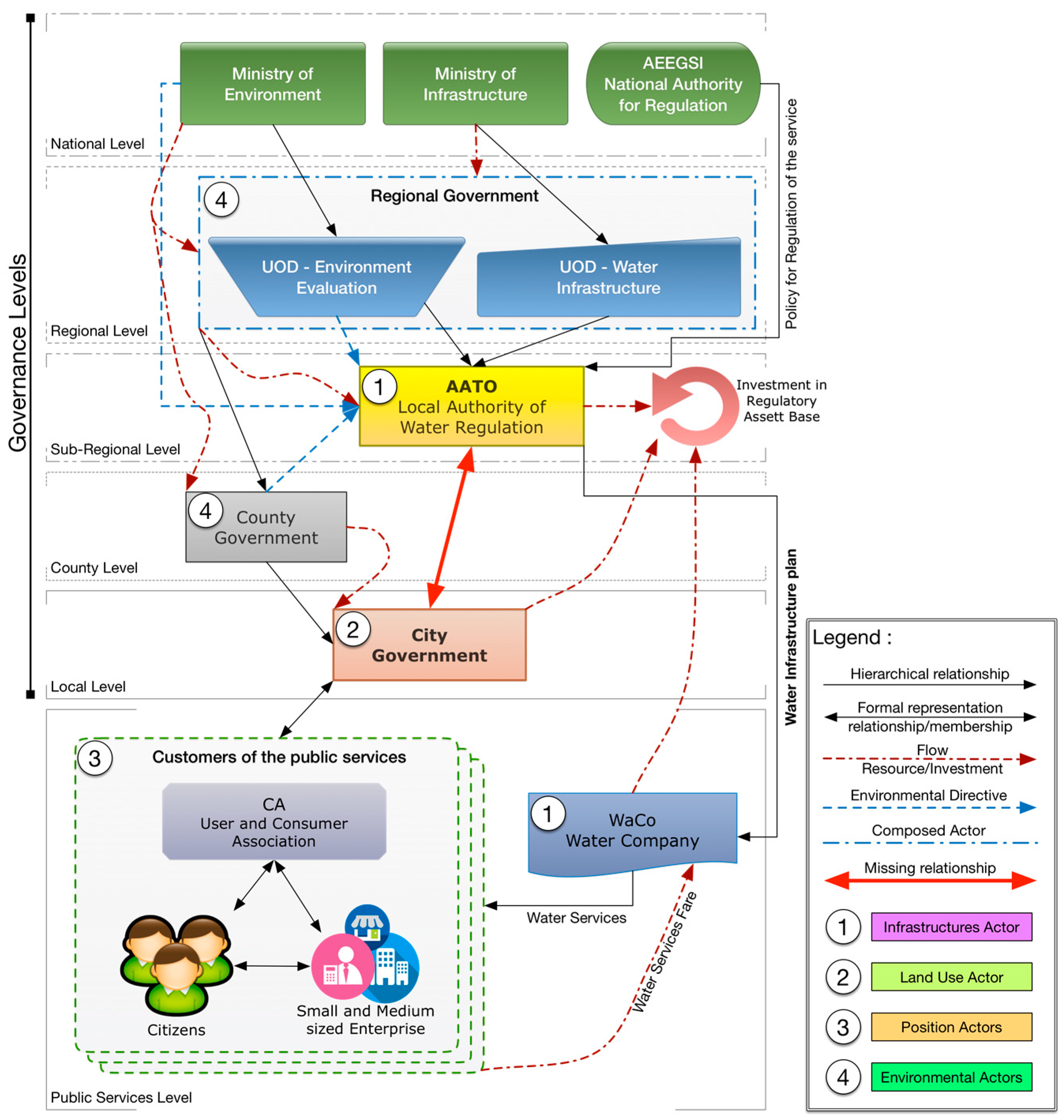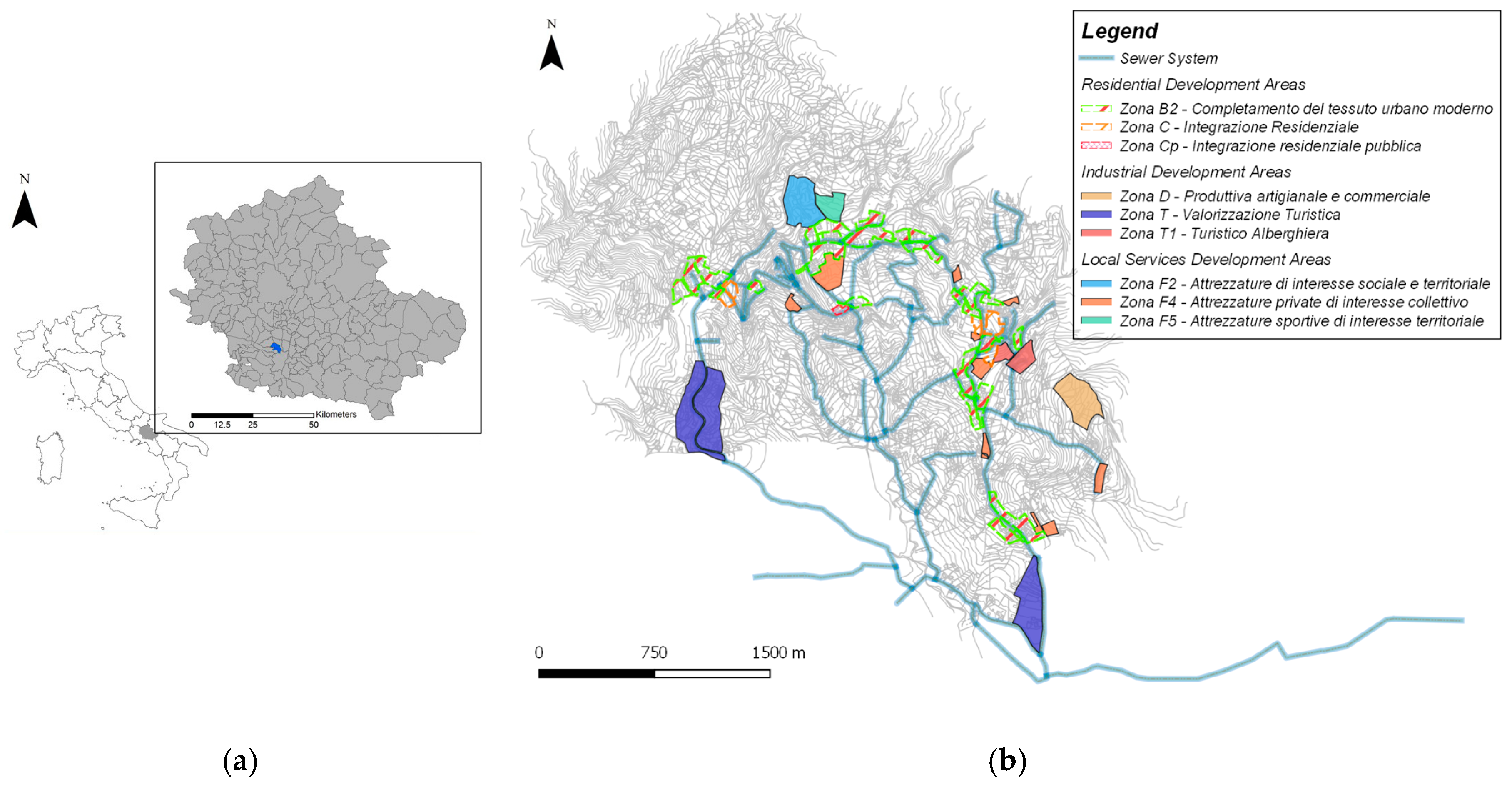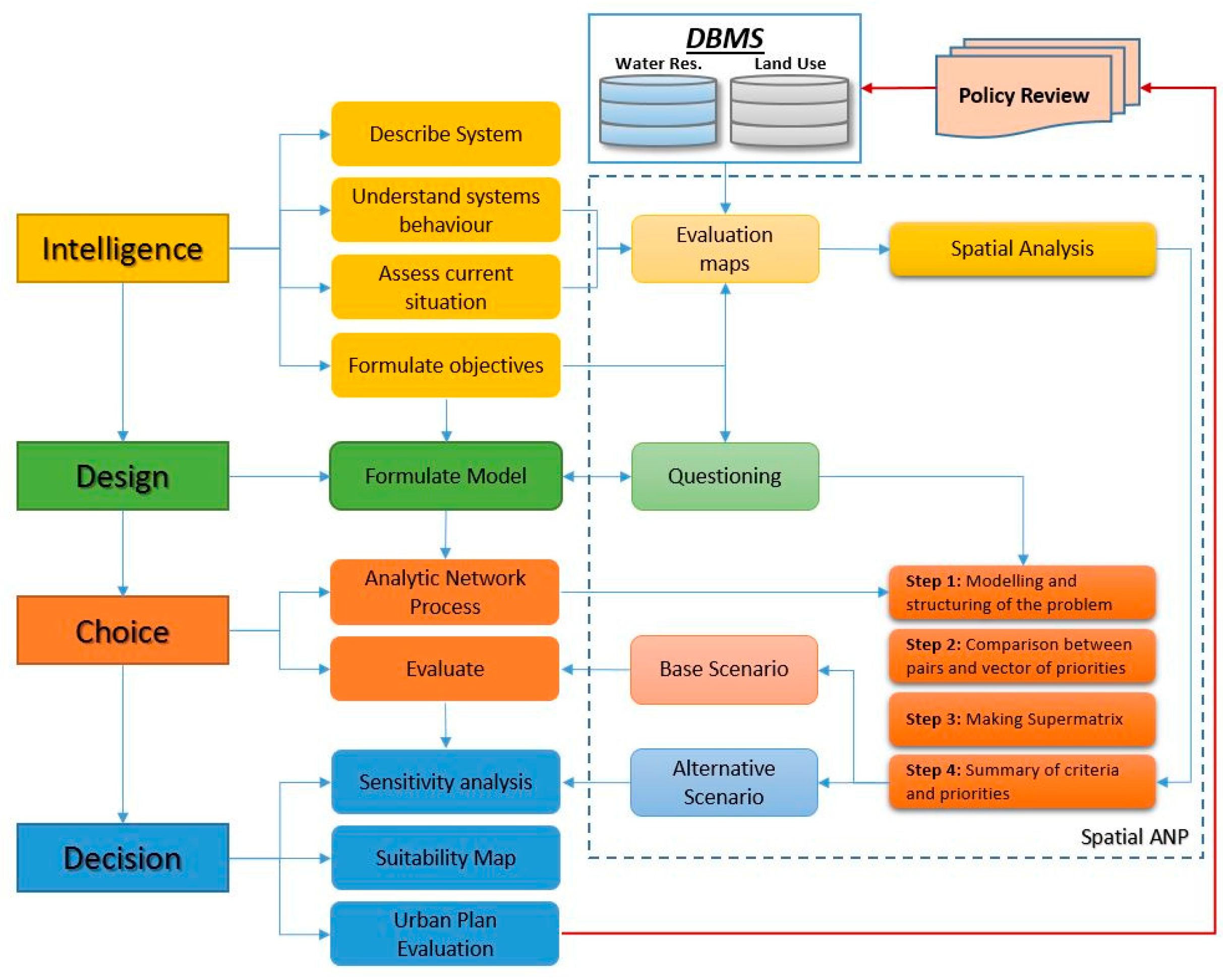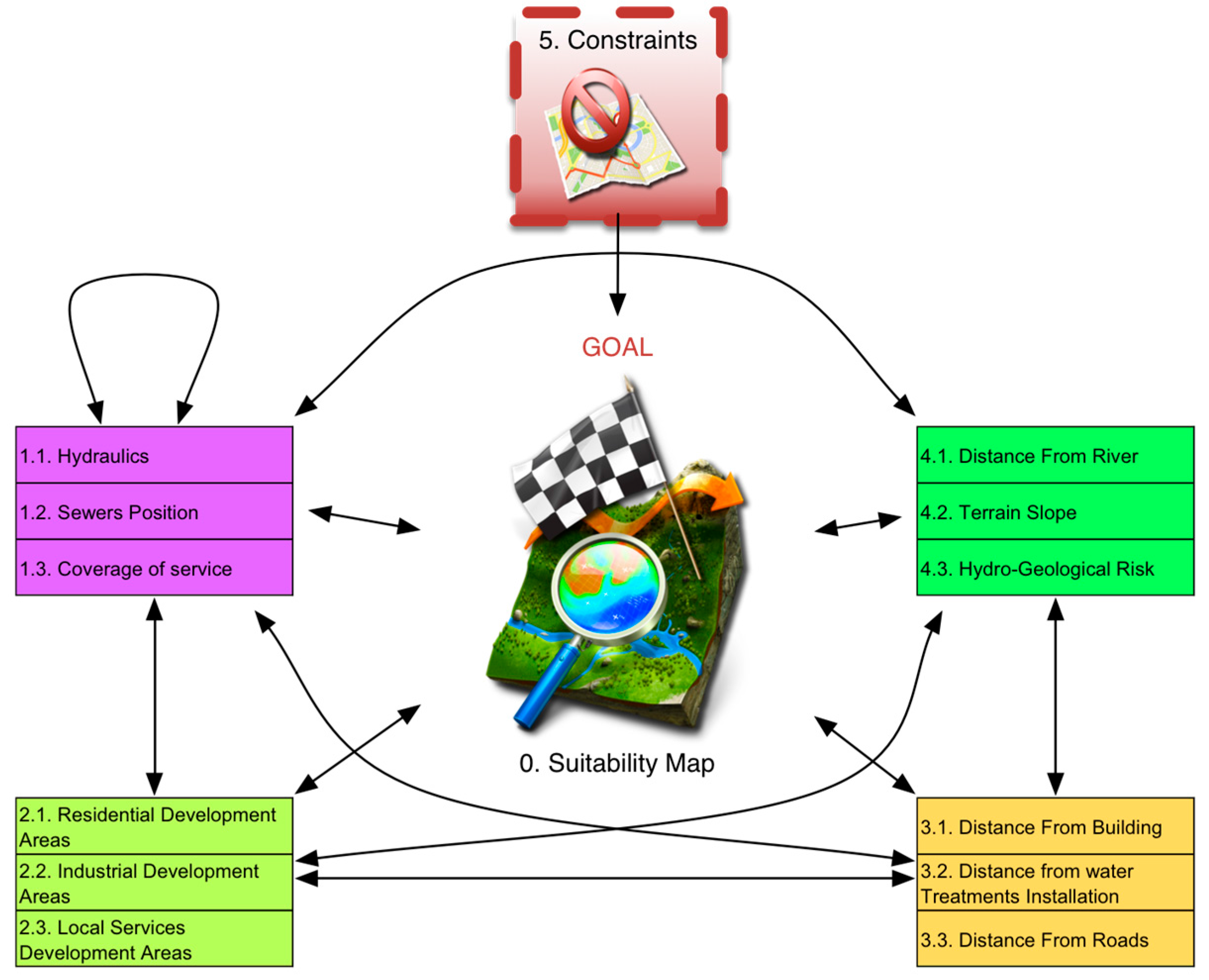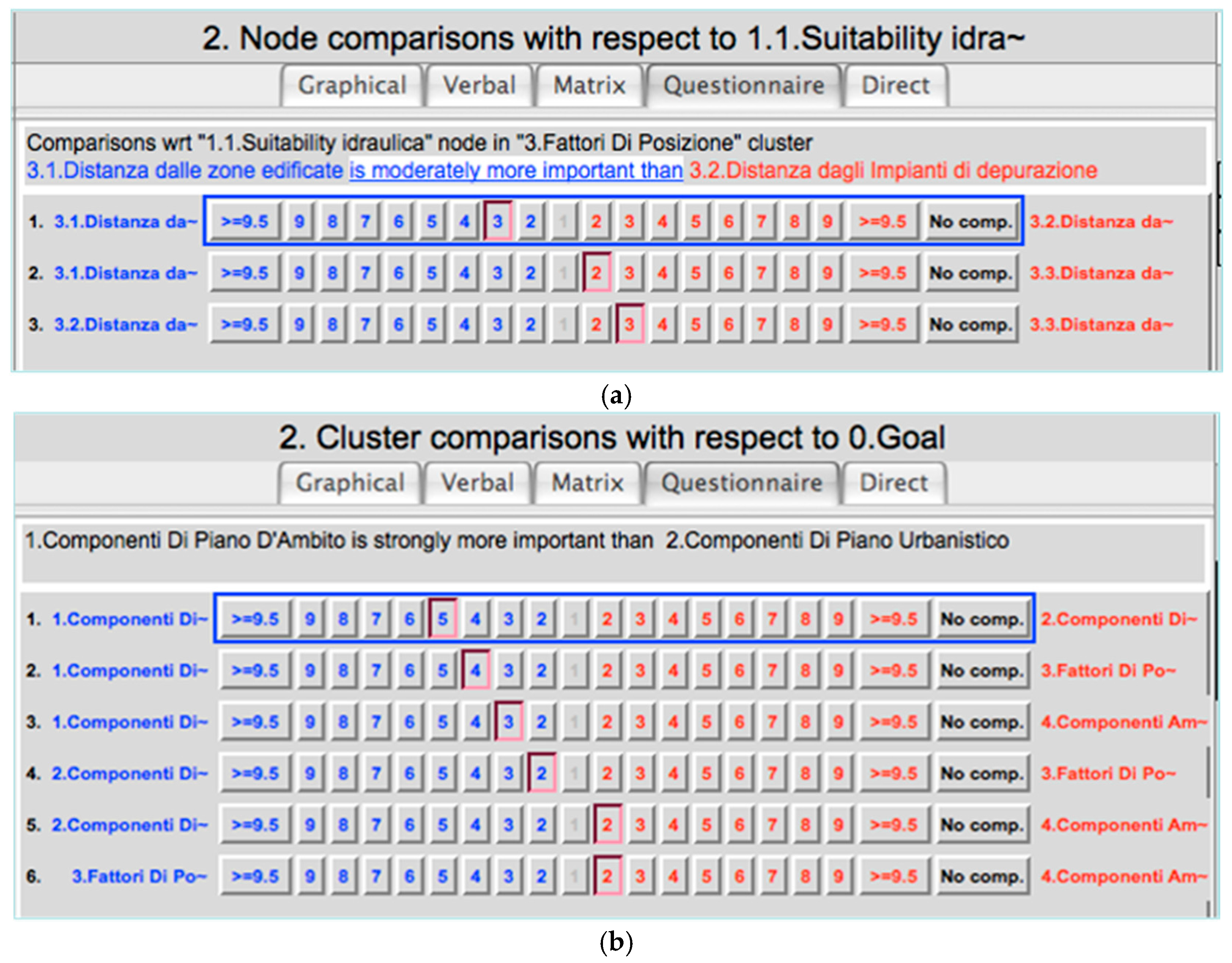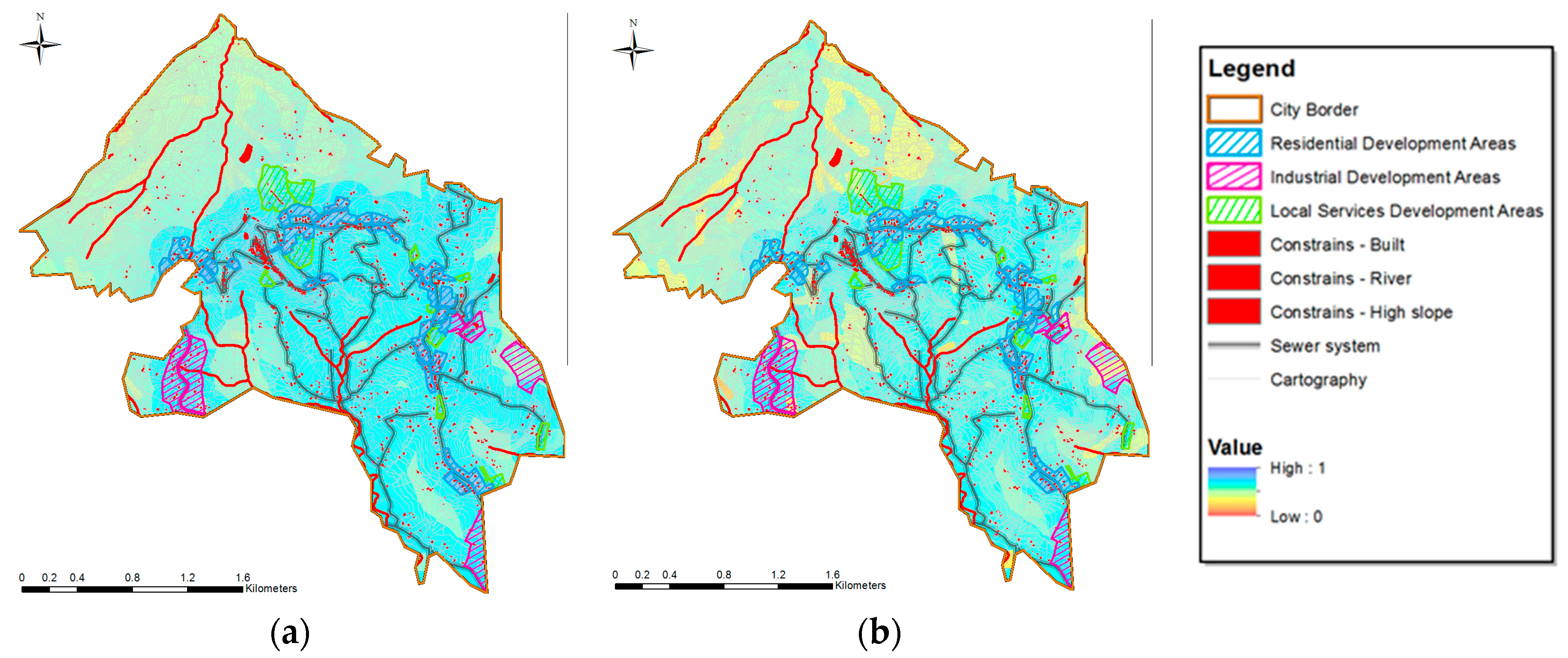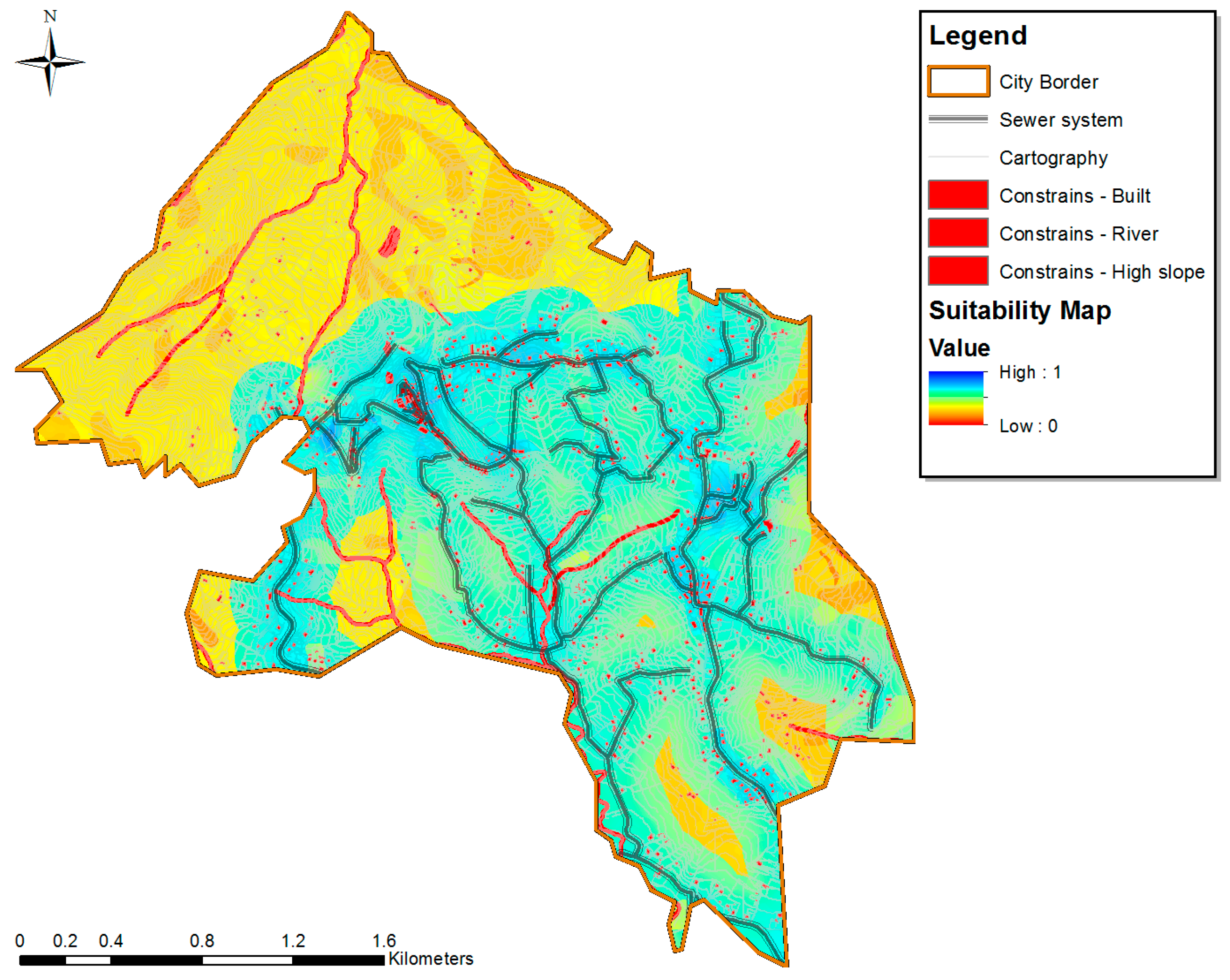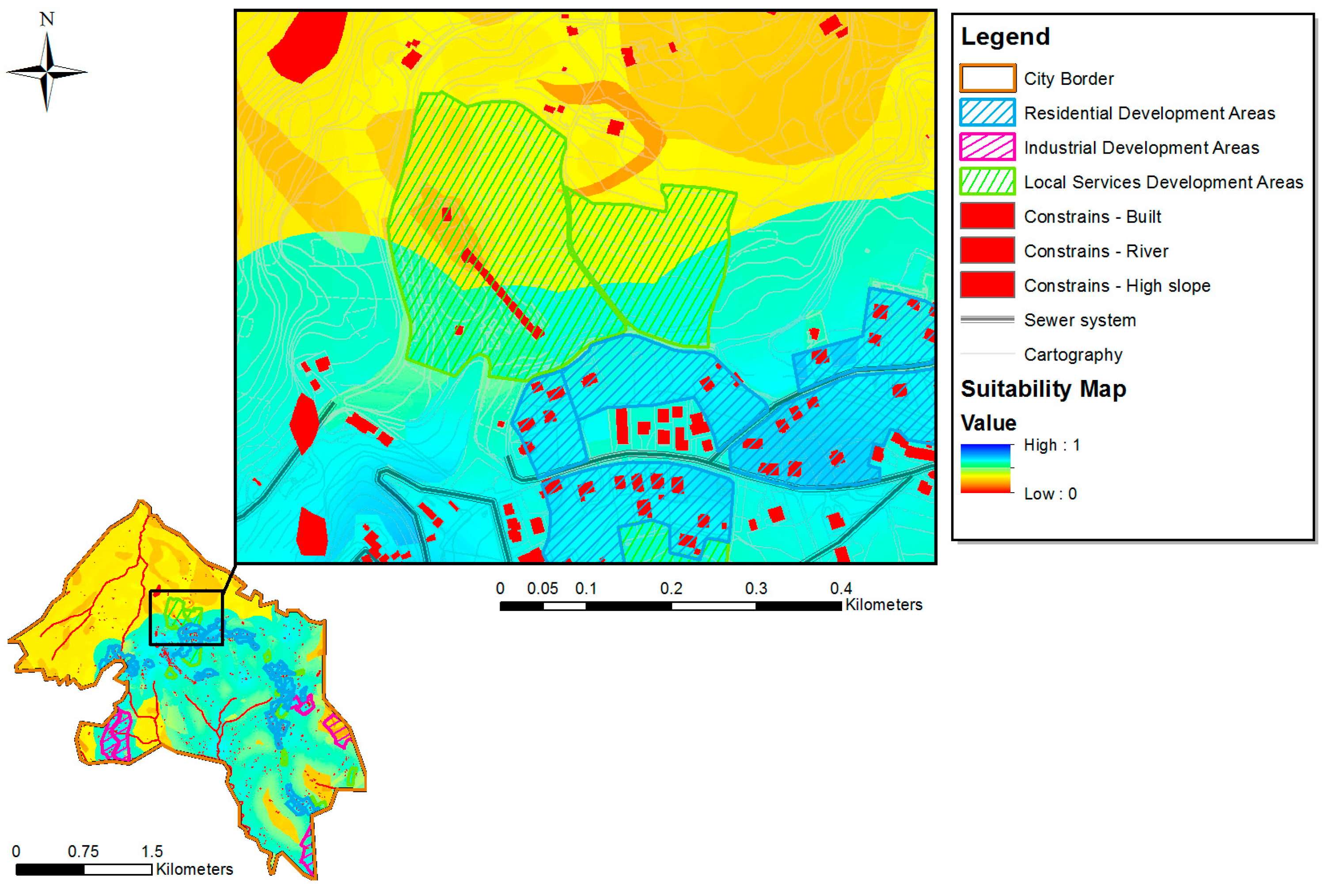1. Introduction
Rapid urbanization has become a major concerns on a planetary level, due to its harmful effects on the environment [
1], including the consumption of soil to the detriment of natural areas and agricultural soil [
2]. This phenomenon has produced a low-density settlement model that produces demand for utility services that has to be fulfilled across increasingly large areas. This demand includes the need for integrated water service. In fact, the demand for water is increasing significantly in all major sectors: agriculture, energy production, industrial uses and human consumption. The latest report of the United Nations [
3] estimates that in contrast to this increase in demand, the availability of fresh water in many regions is likely to decrease due to climate change, and that these pressures will exacerbate economic disparities between some nations and between sectors or regions within countries. Only 2.5% of all the water on our planet is fresh water. Of that fresh water, 70% is in the form of ice, 29% is present in the soil, and only 1% (0.007% of the total) is readily accessible for human uses. If we recall that, of this water, on average more than one third is lost even before reaching the final consumer, is not difficult to understand the attention drawn to this issue.
The main source of demand comes from urban communities that need water for daily use. Nevertheless, water is not only the primary source of livelihood for humans, it is also the raw material needed for the production of energy, goods, and services which, in a cyclical logic, result in a pollution load to handle, dispose and treat. The demand for water is also growing at a rate twice that of the population, and therefore the resulting pollution load produced by the use of water grows in the same proportions.
Moreover, considering that population growth will focus, in the coming years, in urban areas and that to this new demand will be added a previous one due to a backlog of people still to be served, there will be considerable difficulties in planning an infrastructure system that is adequate to future forecasts, and expandable as needed. To meet the need, to ensure sustainable expansion, to operate efficiently, and to maintain a high quality of life for residents, cities will have to approach this problem using smart logic. Making cities smart, to support their own growth, is emerging as a key activity for which there will be
$108 billion invested in this decade according to Navigant Research. Water infrastructure is among the six key areas that characterize smart cities [
4].
The water system should therefore be seen as a complex object made of interconnected parts. The resource has to be considered as a whole, with infrastructure systems needing to be properly planned in order to preserve the water itself and make its use sustainable for the environment. This approach will lead to the simultaneous optimization and reduction of investment costs, which would be otherwise unaffordable due to the high deficiencies that this kind of system usually presents. The management and use of the resource is organized in an integrated infrastructure system that includes the uptake, distribution, disposal and treatment of water. These infrastructures involve a large amount of capital for construction and management, and are designed for long periods of service.
So emerges the need to rationalize the system, starting with the sewer subsector, which if not properly sized and managed, can itself become a contributory cause of pollution for the resource that we are trying to protect.
1.1. Water Service in Italy
Italian water services are suffering a significant infrastructural deficit, in terms of both quality and quantity of supply, and of sewerage systems and water treatments. Even in the fields of management, measurement systems and controlling computer systems require urgent investment to adjust coverage and service levels. Additionally, there is the commitment to the reconstruction of the infrastructure at the end of its useful life, the extraordinary maintenance and technological upgrading needed for the recovery of operational efficiency, and for saving water and energy in systems and networks to combine safety, quality, and continuity of service, environmental protection, and sustainable use of the resource.
Rating agencies in this sector have estimated that water companies (WaCo) in “no growth” scenarios need investments of around €1.6 billion/year as a component of net capital that is estimated will grow to a minimum average of €20 billion/year in the next 30 years [
5]. In addition, the new system for regulating water services fares made by the National Authority for the Regulation of Electrical Energy, Gas and Water System (AEEGESI), introduces a model of full cost recovery for the WaCo, making even clearer the need to avoid unnecessary or poorly sized investments [
6]. In fact, under this new regulatory environment, all the investments will be refunded to the WaCo in any case and paid by users over time, in both economic and environmental terms. In such a context, the planning needs and implementation of investments are of fundamental importance, considered as the engines to achieve
the main goals of quality, affordability, efficiency of service, and the protection of public health and of the environment. Such planning should be the result of the convergence of interests of a network of actors connected by functional relationships, hierarchical and non-hierarchical. The same actors are also affected by cash flows which reinforce the weight of the decision of one actor over another (
Figure 1).
The figure above shows that the National Agencies are “on top” of the hierarchy. They are in charge of setting, by law, the minimum requisites and standards for environmental safeguards, coverage of the services, efficiency, and “fair” regulation of the sector. At the lower level, there is the composed actor, regional government, which consists of two different units. The first is in charge of environmental protection; the second holds property and runs strategical and regional assets (i.e., aqueducts, industrial wastewater treatment plans). At the subregional level, the Local Authority for Regulation of the Integrated Water System (AATO) has the property of local infrastructure, plans the expansion and the extraordinary maintenance of the network, and overlooks the WaCo with local regulations.
Locally there are city governments, which must ensure, through the regulation of land use, an appropriate level of services for citizens—who, like the WaCo, are actors that do not participate in governance of the system. Water infrastructure planning is a complex decisional problem that has no solution in the current planning system.
1.2. Spatial and Urban Planning System
The need to protect water resources, imposed by the European Water Directive (2000/60/CE) consistent with the objective of promoting sustainable development, brings out the need for smart planning of urban infrastructure that has important spatial implications at the regional scale. In fact, the protection and use of water resources are not independent from land use; rather these are reciprocal, consequential, and necessary. The Italian planning system provides a set of plans for land use that are all affected by a second set of plans for environmental protection. The latter, in turn, affect water infrastructure plans. However, analysis of the Italian planning system shows that the spatial and urban planning instruments that deal with land use, population, and the protection of the resource, are not interrelated with the Water Infrastructure Plan (WIP), the instrument that leads the Integrated Water System (IWS) and then the use of the water resource (
Figure 2).
This means that the integrated water management system does not take into account how land use is handled, even considering the demographic increase of the area as an input parameter for the WIP. The Water Infrastructure Plan, developed at a subregional scale by the Local Authority AATO, currently sizes the investments for the expansion of the network by looking only at residential service, with the use of a single parameter K, combined with the coverage of the service at city scale. This parameter K represents the supplied services, and is assumed to be constant at the municipal level, and is equal to the ratio between the length of the sewer system and the number of users currently served, as declared by the WaCo. From a different perspective, the city plan instead provides an increase of the load settlement, and so of water services needed, in terms of new inhabitants distributed in residential areas as well as of expansion areas for non-residential functions. Moreover, the forecasts of the WIP are made for a long term period of 20–30 years, while forecasts of the city plan are made for the medium term of 10 years.
This dichotomy in the planning of land use and water use—which are, of course, interconnected in daily life—creates inefficiencies and mismatches between needs and solutions, with the failure of the integrated water system.
Currently, several critical issues are affecting the planning system described:
Lack of sufficient data to characterize the whole system of the service networks. These data consist of many elements, made at different times and with different states of use and efficiency.
Estimation of the service demand, currently performed independently by the WIP without considering the estimation made by city plans in charge of the settlement development.
Lack of a spatial allocation of the service demand.
The absence of a spatial location for the investments eventually needed.
Lack of feedback towards city plans.
Hence emerges the need for integration between responsible planning of the investments of the water infrastructure system and urban planning at the local scale.
1.3. Objectives and Proposal
In this sector of studies, we need a reorganization of the planning system to introduce an input–feedback mechanism between the Water Infrastructure Plan and city plans, from the perspective of smart integrated planning (
Figure 2). Only synergy between these two levels of planning will allow the IWS to reach the coveted objectives of effectiveness, efficiency, economy, and environmental sustainability. To make explicit this functional link between planning tools, this study proposes a methodology that involves the creation of a suitability map of investments in the system. This map, built according to the current city plan’s forecast, allows both to plan the extension of the service in the territory and to review the same base forecasts for the WIP. These forecasts, in fact, are seldom built with consideration of this functional relationship. Specifically, given the nature of the spatial planning of urban infrastructure, this paper uses a multi-criteria spatial decision support system (MC-SDSS) that integrates the methodologies of three research areas: geographic information systems (GIS), database management systems (DBMS), and multi-criteria decision analysis (MCDA) [
7,
8]. Much progress has been made over the last 20 years in developing methods of multi-criteria land suitability evaluation, especially in integrating GIS with S-MCE [
9,
10,
11,
12,
13,
14,
15,
16]. Multi-criteria land suitability evaluation (LSE) is one of the best known application domains of spatial multi-criteria evaluation [
12,
17,
18,
19,
20,
21]. In particular, because of the relationships between the instruments of regulation and planning, these are compared by a multi-criteria spatial analysis of network type, analytic network process (ANP) [
22,
23]. The methodology was tested with reference to the sewerage component of the integrated water system, because the availability of data connected to the water components is strongly influenced by operating parameters that are not always available, such as operating pressure.
3. Results and Discussion
The evaluation process, by weighing the various factors that affect the localization of new users or network extension positively or negatively, leads to the realization of the final suitability map, illustrated in
Figure 11. Comparisons between different scenarios and the base suitability map through the sensitivity analysis allow further methodological considerations on the procedure adopted.
In fact, by examining the differences between the maps of the scenarios, it is possible to find convergence of the areas with greater suitability with the base result.
The application tested on the sample town has, in fact, made it possible to evaluate the choices of the current city plan from the overlay with the suitability map following major feedback considerations on the expansion areas planned by the city plan itself (
Figure 12).
Based on our results we can see that a significant portion of the territory is unsuitable to host new users or extensions of the network, while the territories with higher suitability values are concentrated mainly in areas already urbanized and served. The areas of residential expansion planned by the city plan are well merged into the existing urban fabric, presenting high levels of suitability for which it is possible to suggest the exclusion of investments for expansion of the network initially planned by the WIP and needed to cover of this additional demand. All scenarios share the result that some planned areas for expanding productive activities and service areas are located in places with low suitability (
Figure 13 and
Figure 14).
In these areas, in fact, sewerage is not present. Therefore, these areas will be served by realizing specific works, for which their costs will increase in inverse proportion to the suitability of the area itself. This case constitutes a constructive criticism of the city plan, because locating these areas in such contexts has indirectly increased the costs of their transformation, as the costs of the urbanization infrastructure related-costs will be high. Data analysis, then, allows us to evaluate the choices made in the city plan regarding the placement of additional demand of services. On one hand, it has allowed us to eliminate part of the work for extending the network, because part of the demand has been placed in areas already efficiently served. On the other hand, our analysis shows us how a demand that is spatially undefined, or in the wrong area, will result in increasing investment costs if we get away from the concept of densification of services and building. In highly urbanized and dense areas, with high service coverage, the ratio representing the infrastructure endowment per capita served (K), generally has low values. This means that in these areas with a few meters of a network, it is possible to serve more users with lower implementation and management costs. Conversely, in slightly urbanized and scattered areas with low service coverage, it takes many meters of network to serve a few users, which results in very high costs of implementation and management. In this context, the logic of densification is the one that allows us to combine all the different aspects examined, especially those of economy and efficiency. This application shows that the method allows us to optimize the size and localization of investments necessary to meet service criteria by looking at the actual efficiency of the networks. In fact, comparing the results with the information provided by the WIP in relation to the sample area, it is possible to reduce the investments in the network originally planned by the same WIP. Interesting reflections of the results arise also from the sensitivity analysis (SA) developed for the application in question; the SA allows us to highlight the problematic aspects of the evaluation process and, at least in principle, to investigate them more thoroughly and to improve them. The spatial sensitivity analysis is, in fact, a process through which the decision maker reaches deeper knowledge about the structure of the problem and a greater awareness regarding the performance of the alternatives, in light of uncertainty and acceptable risk thresholds [
50]. This SA makes explicit how the various decisional elements interact to choose the most valuable solution which is also born from disagreement between decision makers expressed within the process.
4. Conclusions
The application opens a series of reflections on the investigated techniques regarding the use of our methodology to achieve our goals of rearranging methodical planning in this field, using the input–feedback mechanisms between the WIP and the city plan, in pursuit of smart integrated planning. The methodological approach adopted provides substantial support for further assessment. This first step represents a useful knowledge base for the next, more detailed, phase of analysis, which involves the micro-location of investments and the review of city plan policies. In fact, the study case shows that MC-SDSS models are able to offer significant support in the phase of macro-localizing the most suitable areas to host new users, or extend existing networks, and to better integrate them with the existing infrastructure. The service’s targets are redefined with respect to the space component of demand, until now neglected, and with regard to the sections, or urban areas, functionally linked to the directives of the city plan. It is clear that the presence of constraints and decision factors limits the number and geographic extent of alternative spaces. The results show a dutiful disincentive policy for investments placed outside urbanized areas which already suffer of structural weaknesses.
Furthermore, the suitability map allows us to validate the address criteria for urban transformations which have to be followed by the city plan in view of densification rather than expansion of the urban structure in the rural areas. It will be possible to select and compare alternatives, choices, and drivers of the city plan with regard to the infrastructure subsystem that represents the carrier network on which all activities of land use should be developed. Our discussion has highlighted the potential integration of GIS techniques and multi-criteria analysis and explained this approach is very useful in systematically providing transparent and repeatable decision support, thanks to a clear and rational presentation of the results facilitated by the creation of thematic maps. One of the most significant strengths of MC-SDSS models is the support that they provide both for the planning phase, where they can help to generate alternate options, and the evaluation phase, where they allow the comparison of alternatives based on various criteria to make explicit the impacts, levels of tradeoff, and overall attractiveness of the options. Our application shows that multi-criteria spatial analysis can provide effective support to the strategic planning phase of investments in territorial transformation, providing a useful knowledge base for more detailed subsequent analysis (micro-localization). In fact, according to our results, the potential benefits of the spatial ANP approach for defining the investments of territorial transformation appear to be plentiful. First, the analysis highlights what factors are most significant for the decision through a transparent evaluation process. Future research will refer to the extension of the methodology to the other component of water infrastructure, the water distribution network. We also intend to develop a sensitivity analysis based on generating multiple combinations of weights, to be associated with several criteria, in order to take due account of various uncertainties [
51,
52], and the integration of ANP with Fuzzy TOPSIS methods [
53,
54]. Indeed, this case study has showed that the limits of a multi-criteria spatial analysis essentially rely on the availability and accessibility of spatial data, which are rarely public and are scattered among various agencies, as well as the need for preliminary data processing before data can be used in MC-SDSS software. The widespread implementation, on the national level, of this methodology needs a legal obligation to address and regulate the participation of different actors in the decision-making process, while at the same time formalizing the link between city plans and the Water Infrastructure Plan. However, since there are no technical difficulties in the implementation (it is simply necessary to expand the database of WIP with the data on the land use and environmental constraints), we hope in application trials to boost sector governance to provide for the regulatory address that is needed.
